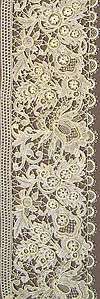Point de France
Point de France is a type of needle lace developed in the late 17th century.[1] It is characterized by rich and symmetrical detail, and a reliance on symbols associated with King Louis XIV of France, such as suns, sunflowers, fleurs-de-lys, and crowns. [2]

History
During the 1660s, King Louis XIV of France was spending extravagant sums on lace from the Republic of Venice, particularly a type known as point de Venise, to the dismay of his finance minister, Jean-Baptiste Colbert.[1] In order to redirect this spending into the French economy, Colbert set up a number of official royal lace factories, which were to produce a type of lace he named point de France. He worked with the French ambassador to Venice to tempt needle-workers from Venice, Italy, and Flanders to emigrate to France, prompting the Doge of Venice to declare that defection to France by needle-workers was a treasonous act punishable by execution or assassination.[1][3] It is unclear whether this threat was ever carried out; regardless, enough Venetian needle-workers emigrated that the French quickly learned to produce high-quality lace.[3][2]
Point de France was popularized by the clergy, who used it for the ornaments of their rochets, a type of clerical vestment.
Most surviving pieces from the 16th and 17th centuries are now in museums.
References
| Wikimedia Commons has media related to Point de France. |
- St. Clair, Kassia (2018). The Golden Thread: How Fabric Changed History. London: John Murray. pp. 146–147. ISBN 978-1-4736-5903-2. OCLC 1057250632.
- St Clair 2018, p. 148.
- Earnshaw, Pat (1999-01-01). A Dictionary of Lace. Courier Corporation. p. 130. ISBN 978-0-486-40482-0.
